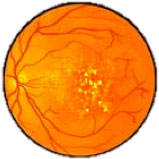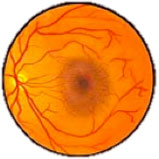Age-Related Macular Degeneration

Enjoy your life to the fullest while living with age-related macular degeneration. Learn about the latest treatment options and how to maximize your remaining vision through low vision rehabilitation.
Moore Eye Institute’s Dr. Leonard Ginsburg, Dr. Shyam Kodati, and Dr. Joshua Steiner are expert macular degeneration specialists who help patients preserve and make the most of their precious vision.
What is AMD?
Age-Related Macular Degeneration (AMD) is deterioration of the eye’s macula. The macula is a small area of the retina comprised of light-sensitive tissue responsible for your central detailed vision.

AMD is the most common macular problem, and develops as part of the body’s natural aging process. It generally develops in one eye, although it may affect the other later. Most people do not realize they have AMD until they notice vision problems.
The images to the right show how two little boys appear to someone with normal vision and then to someone with age-related macular degeneration. In the second image, you can see a depiction of central vision loss.
Dry Macular Degeneration

Dry Macular Degeneration is the most common form of AMD caused by aging and thinning of the macula. Vision loss is usually gradual. After being diagnosed, vision must be consistently monitored.
Dry Signs & Symptoms:
- Blurry distance and/or reading vision
- Increasing need for bright light to see up close
- Colors appearing less vivid
- Hazy vision
- Difficulty transitioning from bright to dim lighting
- Difficulty recognizing faces
- Blank or blurry spot in central vision
Wet Macular Degeneration

Wet Macular Degeneration causes more damage to the central detailed vision and affects about 10% of those with AMD. It occurs when abnormal blood vessels grow underneath the retina, a process called neovascularization. Vision loss may be fast and noticeable. It is important to diagnose and treat wet AMD early to preserve as much vision as possible.
Wet Signs & Symptoms:
- Distorted vision
- Dark gray or blank spots in vision
- Loss of central vision
- Size of objects appearing different for each eye
- Loss of color brightness
- Symptoms may appear and worsen fairly quickly
Diagnosis
It is important to have annual eye exams with an AMD specialist since many people do not realize that they have a macular problem until a vision problem is apparent. Regular eye exams help detect abnormalities and early stages of AMD.
Treatment
Unfortunately, there is no proven treatment for dry AMD. However, a large study has shown that antioxidant vitamins and zinc may reduce the impact of dry AMD by slowing its progression.
Medication Injections
A steroid medication can be used to treat wet AMD. Alternatively, an anti-VEGF medication can be used to block vascular endothelial growth factor, VEGF, a substance that contributes to abnormal blood vessel growth. The medication is injected into the back chamber of the eye after it has been dilated and numbed. The medicine reduces swelling, leakage, and unwanted growth, possibly improving vision.
Watch this video to learn more about age-related macular degeneration.
Watch this video to learn more about injection treatments for AMD.
